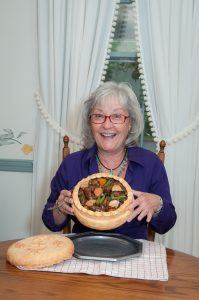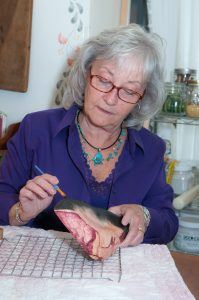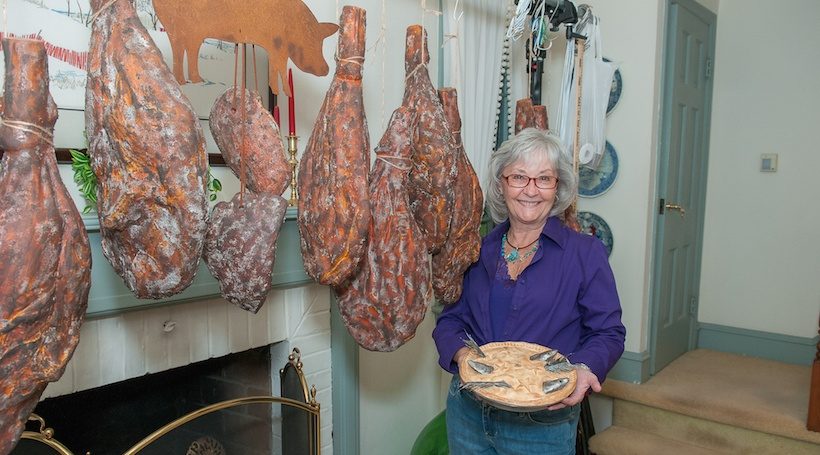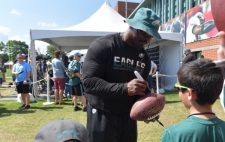If you’ve ever been to a museum and noticed how real the displayed food looked, you’ve probably seen Sandy Levins’ work. The Haddon Township faux-food artist is queen of her craft -– quite surprising for someone with no art background who admittedly hates to cook.
“When I joined the board of the Camden County Historical Society in 2000, we had a wonderful 18th-century authentically restored Quaker mansion,” recalls Levins, 65. “It’s got a great open-hearth kitchen that we still use for cooking and a lovely dining room. One of our prized possessions is a tea table in the parlor. But there was not a lick of food to be found anywhere. You wouldn’t have known walking into that house that this was once a beehive of activity. We decided to introduce the shocking concept that everybody ate.”
 So started Levins business, Historic Faux Foods, which has provided realistic-looking foods to the most esteemed museums and historical homes in the country. A quick look at the 19th-century beer saloon luncheon spread at New York’s Tenement Museum, and you’ll see that Levins gives painstaking attention to detail.
So started Levins business, Historic Faux Foods, which has provided realistic-looking foods to the most esteemed museums and historical homes in the country. A quick look at the 19th-century beer saloon luncheon spread at New York’s Tenement Museum, and you’ll see that Levins gives painstaking attention to detail.
Presently 60 pieces of faux smoked meat – hams, slabs of bacon, hog jousts and pork shoulders – are hanging from her living room ceiling. Soon they will head to Mount Vernon’s refurbished smokehouse.
“When you introduce food to an historic site, you tend to engage your visitors on another level,” she explains. “Historic sites are competing with so many other distractions like the Internet and video games, so they are always looking for something a little different to bring in people. Food is something people are beginning to gravitate to.”
And to bring people back, displays must evolve and change, which gives Levins job security.
“The biggest challenge comes with some clients’ requests that really don’t translate well from real food into faux food,” she says. “Either the texture is something you just can’t realistically duplicate, or the size is prohibitive, or it’s just something that’s incredibly bizarre and I’d rather not do it.”
Such was the request for a 16th-century dish that was made by sewing together pieces of different animals. “It was disgusting, so I passed on that one,” she says.
Yet, the raw beef tongue for Independence National Historic Park passed her muster. “I have only seen pictures of cows with their tongues out so I had no idea how large, long and bloody a raw beef tongue was. I purchased one to make molds from and then cast the food from those molds. I went to a butcher in South Jersey, and he asked me how fresh I wanted it. Did I want one that was just talking to him two hours ago? I was surprised at how colorful a cow’s tongue could be, in shades of greys, blacks and pinks.”
Another challenge was the peacock pie for Historic Odessa in Delaware, which in the 18th century was adorned with the animal’s real neck, head and tail feathers for the table presentation. “In order to get an idea of what a peacock neck and head would look like, I actually sent for some taxidermy supplies and ordered a little skull made in resin and basically built the face onto this peacock skull. The worst thing you can do is give someone a piece of faux food, and it looks like a cartoon.”
Levins admits to her share of do-overs. “There have been a lot of things that haven’t worked,” she says. “You think you know how a material is going to work when you’ve used it for a while, but then when you actually see it made up, it just doesn’t look right. You scrap it and go back to the drawing board with another plan.”
Levins warns the food in an historic site will not look like the food on our kitchen tables. In the 18th century, chickens were less plump and meats were boiled to a drab gray instead of roasted to a beautiful brown. That means Levins must spend much of her time on research, studying what the food looked like during a specific time period.
 “I have an entire library that I built up over 13 years of period cookbooks, reference books, food encyclopedias and even some wonderful books by the Dutch masters who did beautiful food still lifes. They give you a sense of what food looked like in the 16th, 17th and 18th centuries.
“I have an entire library that I built up over 13 years of period cookbooks, reference books, food encyclopedias and even some wonderful books by the Dutch masters who did beautiful food still lifes. They give you a sense of what food looked like in the 16th, 17th and 18th centuries.
“When a client comes to me with a request, first I have to find out whether the food would have been appropriate for that location and time period. What did it look like? How would it have been prepared? Faux food, when done right, is expensive and becomes part of a site’s permanent collection,” Levins says.
She also carefully considers her audience, such as the time she had planned to make a boar’s head for Pomona Hall in Camden. “Because we have so many school groups coming in to tour, the idea of a wild boar’s head with a long snout and tusks would have been a little scary for fourth graders,” Levins says. “So we went the route of doing a hog’s head. It had to be suitably greasy looking with the eyes, ears and snout.”
And where there’s food, there are critters, so the artist has become adept at making faux vermin too. “A client ordered Civil War rations and asked if I could properly infest some of the hard tack biscuits with worms and salt pork with maggots,” says Levins.
“My next big commission is going to be the John James Audubon House, which is down in the Florida Keys,” she says. “High on their list are dishes prepared with green sea turtles. I’m not a fan of turtle soup, but the turtle soup you get today is nothing like the turtle soup prepared in the 18th or early 19th centuries. They used turtles that might have weighed up to 300 or 400 pounds.”
She admits the research is where most of the fun comes in. “When you create something and somebody wants 20 of the same thing, once you’re done researching it and you’ve done your first three or four pieces, it gets a little tedious. I’m not learning anything or growing in my profession.”
Levins has certainly grown enough to draw accolades from the likes of “Early American Life” magazine, considered the bible for curators and museum professionals. “To be recognized by them as one of their top artisans in their annual directory is a tremendous honor for me,” she admits. And quite a feat for someone with a background in medical records administration.
Just remember, if you’re ever a guest in Levins’ home, you may not want to reach for the cookies in the kitchen that look like they’d melt in your mouth. (She’s really good at what she does.)














